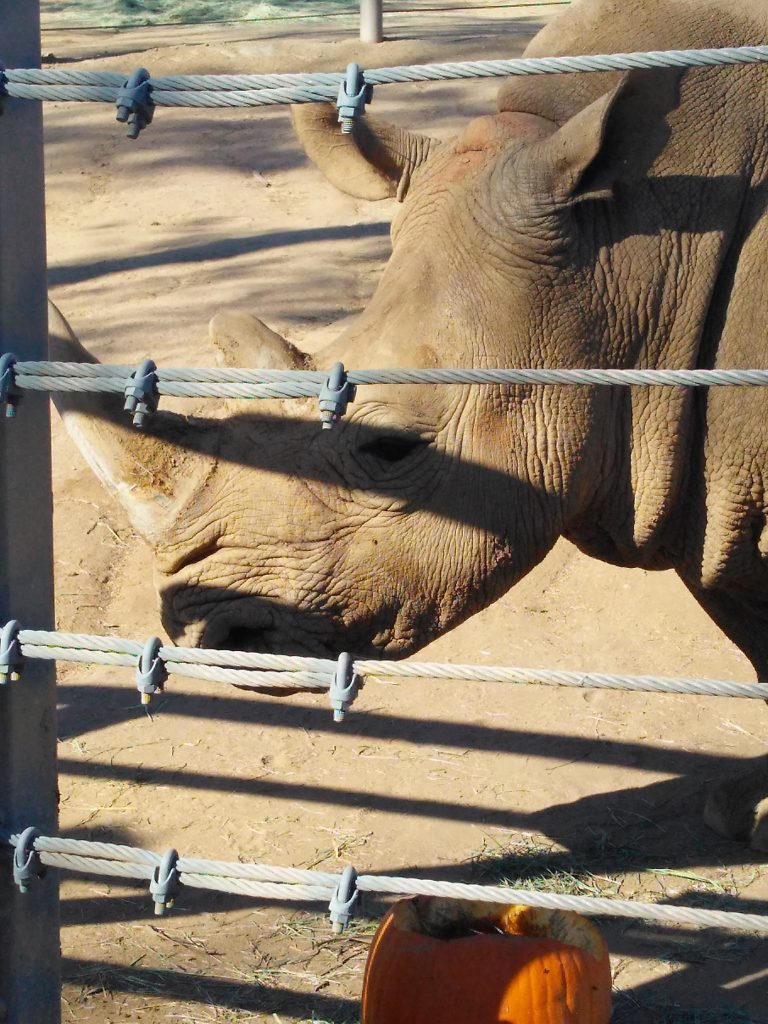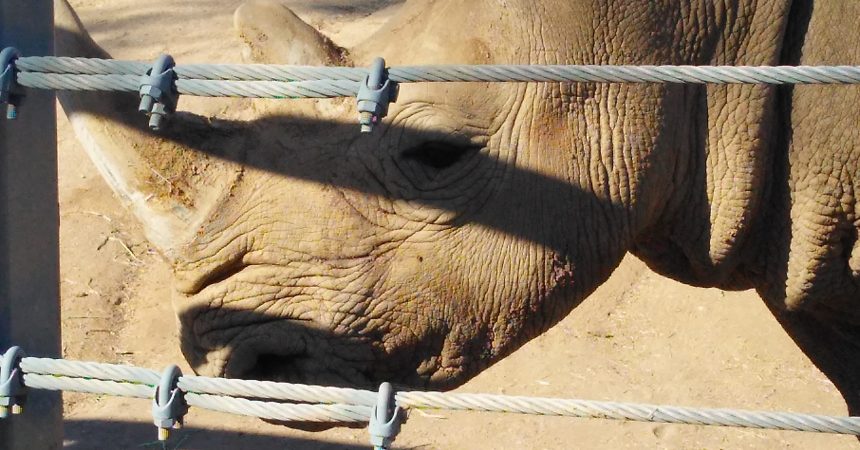Zoo InternQuest is a seven-week career exploration program for San Diego County high school juniors and seniors. Students have the unique opportunity to meet professionals working for the San Diego Zoo, Safari Park, and Institute for Conservation Research, learn about their jobs, and then blog about their experience online. Follow their adventure here on the Zoo’s website!
 Last Thursday, we got to meet Jonnie Capiro, the Lead Keeper at the Rhino Rescue Center. She and her team care for the Safari Park’s six southern white rhinos: Amani, Victoria, Nikita, Helene, Wallis, and Livia. These southern white rhinos are key in the Zoo’s efforts to save the functionally extinct northern white rhino. Unfortunately, there are only two left on the planet. Once the reproductive technology is developed and perfected, the southern white rhinos could serve as surrogate mothers to northern white rhino calves, saving the species from extinction. Here’s a bit more about these modern-day dinosaurs.
Last Thursday, we got to meet Jonnie Capiro, the Lead Keeper at the Rhino Rescue Center. She and her team care for the Safari Park’s six southern white rhinos: Amani, Victoria, Nikita, Helene, Wallis, and Livia. These southern white rhinos are key in the Zoo’s efforts to save the functionally extinct northern white rhino. Unfortunately, there are only two left on the planet. Once the reproductive technology is developed and perfected, the southern white rhinos could serve as surrogate mothers to northern white rhino calves, saving the species from extinction. Here’s a bit more about these modern-day dinosaurs.
Southern white rhinos are listed as near threatened by the International Union for the Conservation of Nature. Poaching continues to threaten their survival, and the Zoo has partnered with the International Rhino Foundation to help protect southern white rhino populations in South Africa.
Ms. Capiro described the southern white rhinos as having the intellect of a lazy toddler. When training rhinos, she uses a method called positive reinforcement, where a behavior desired by the trainer is paired with a reward for the rhino, usually food or a scratch behind the ear. Over time, the rhino will voluntarily repeat the behavior since they are rewarded for it. Since they eat most of the time, consuming two bales of hay per day between the six of them, motivating the rhinos to participate in training can be a bit of a challenge. However, just because they aren’t always the most motivated doesn’t mean they’re not smart. For instance, Nikita learned to open her mouth on cue just by watching Amani’s training sessions.
Training these rhinos allows researchers to learn more about their reproductive physiology and aids in the development of assisted reproductive technologies such as artificial insemination and in vitro fertilization, processes that might be used sometime in the far future to save northern white rhinos from extinction. Southern white rhinos at the Rhino Rescue Center undergo rectal ultrasounds twice a week to monitor their reproductive cycle. Thanks to the training done by Ms. Capiro and her team, this procedure can be done without the use of sedation.
These ultrasounds also help researchers time artificial insemination procedures so that they have the highest chance of fertilizing an egg. At the moment, there are two rhinos at the Rhino Rescue Center that have been successfully impregnated using artificial insemination. Since the gestation period for a southern white rhino is about sixteen to seventeen months, and the two pregnant rhinos are currently three and eight months along, there is still quite a bit of waiting to do before the calves arrive.
Finally, Ms. Capiro shared with us that each of the six rhinos has their own distinct personality. Amani is the most playful of the six, while Helene is easily the most stubborn and independent. Nikita started out scared and shy, but has become very sweet and comes up to greet visitors. Victoria is a bit of a diva and very food motivated, while Livia gets along with everyone and doesn’t start drama. Last, but not least, Wallis is tiny and tough. She came to the Rhino Rescue Center with a bullet in her from a failed poaching attempt, but has since recovered.
With the information gathered and assisted reproductive technologies developed, each of these rhinos are playing an important role in saving their species. The training that Ms. Capiro and her team does greatly aids in these research efforts. After learning more about rhinos and their unique personalities, I can tell there is never a dull day at the Rhino Rescue Center.
Kelsey, Species Spotlight Team
Week Four, Fall Session 2018


